HOLLAND, MI — The July sun beat down as Casey Walker weaved among Lake Michigan beachgoers at Holland State Park, picking up litter. In his bag, Walker carried cigarette buts, wrappers, plastic bottles and other typical beach trash — but there was one form of garbage he couldn’t really pick up, even though he and everyone else were surrounded by it.
All around, tiny plastic fragments littered the sand.
“You’d need to comb the whole beach with a sifter to try to get it all,” said Walker, a salesperson at Great Lakes Wine & Spirits who was volunteering with an Adopt-A-Beach cleanup July 28. “Once I started looking at the ground, I started seeing it everywhere.”
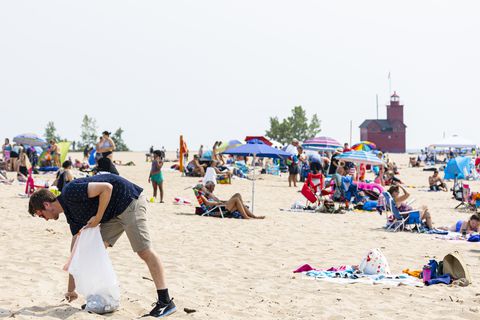
Volunteer, Casey Walker of Holland, picks up trash during an Adopt-A-Beach cleanup at Holland State Park in Holland, Michigan on Wednesday, July 28, 2021. (Joel Bissell | MLive.com)
Unfortunately, Holland is far from the only Great Lakes town with a beach awash in plastic. Broken down bits of bottle caps, wrappers, beach toys — as well as non-consumer items like pre-manufactured “nurdle” pellets — have become a staple of shorelines; accumulating at popular beaches where people come on holiday, daytrips or just to catch a sunset.
But researchers who are tracking plastic pollution in the Great Lakes say the problem goes deeper than beach litter. Humans and animals are ingesting plastic particles released into the environment. Studies are finding microscopic plastic fibers in drinking water, beer, and fish — raising questions about what affect those particles may have on people’s health as well as the health of ecosystems which are absorbing plastic at the base of the food web.
Meanwhile, studies show the volume of plastic in the lakes is getting worse. Researchers say various stewardship efforts aren’t making much dent in the flow of plastic of any size into the lakes, where items can travel long distances before sinking to the bottom, washing ashore somewhere or breaking down and being eaten by birds, fish or insects.
Five years ago, researchers at the Rochester Institute of Technology (RIT) estimated that 22 million pounds (10,000 metric tons) of plastic debris are entering the Great Lakes annually from the U.S. and Canada. Rather than accumulating in “garbage patches” as plastic tends to do in the oceans, lake currents swirl that debris around, breaking it down and sending Chicago and Milwaukee’s plastic onto beaches in western Michigan, or Detroit and Cleveland’s trash to shorelines in Pennsylvania and New York.
Along the way, it can absorb contaminants such as PFAS, DDT or PCBs, turning the smaller, “microplastic” sized pieces less than five millimeters in size into new vectors for toxic chemical exposure once they’re ingested by fish which are, potentially, consumed by humans.
The extent of the problem is, unfortunately, far from being clear. Relatively few studies have examined the environmental risks from either “micro” or “macro” plastics in freshwater systems like the Great Lakes compared to the oceans, even though such lakes and river systems tend to be the first waters that industrial or consumer plastic debris reaches.
“When people think of plastic pollution, they tend to think of the oceans,” said Sherri Mason, sustainability coordinator at Penn State Behrend who conducted some of the initial studies on microplastic in the Great Lakes as a researcher in New York.
“I think it’s because of the visuals that are associated with oceanic plastic pollution. It’s quite impactful. You don’t see the same kind of images when it comes to the Great Lakes,” Mason said. “But nevertheless, if you look upstream from the oceans, you’ll see that most plastic is making its way to the oceans through freshwater systems.”
How much plastic is in the Great Lakes?
In the decades since synthetic polymer manufacturing advances begat the rise of mass-produced plastic in the 1950s, more than 8 billion metric tons has been made worldwide.
The versatile material revolutionized society. But it doesn’t just go away when we’re done with it. Full decomposition takes hundreds of years for even simple, single-use items such as plastic bottles or straws. Some of is incinerated, some of is recycled, but most plastic ends up in landfills. Unfortunately, a lot of it also ends up in oceans, lakes and rivers.
In the Great Lakes, the big number is 22 million pounds entering the lakes annually — a 2016 figure that study authors say was developed based on population estimates around each lake and modeling of how much plastic waste certain zip codes produce.
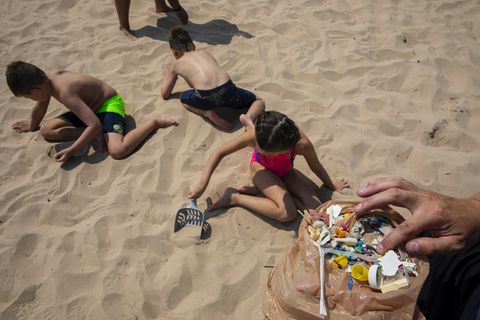
Children pick up plastic debris on North Beach in South Haven, MI. (Joel Bissell | MLive.com)
Of that, the study concluded that half of the plastic pollution entering the Great Lakes, about 11 million pounds each year, goes into Lake Michigan. The next highest load is to Lake Erie, which gets about 5.5 million pounds. Lake Ontario gets about 3 million pounds. Lake Huron gets about 1.3 million pounds and Lake Superior gets about 70,000 pounds.
Over time, natural wear and abrasion, sunlight and ultraviolet radiation break larger pieces down into smaller fragments. Eventually, they become microplastics.
“Consistently, once we look at years and years of data, we see that about 85 percent of what our team leaders pick up is made either wholly or partly of plastic,” said Jennifer Caddick, who coordinates the Adopt-A-Beach program at the Alliance for the Great Lakes nonprofit in Chicago. “That’s a data point we’ve been able to extract pretty consistently.”
Dealing with the problem is an expensive proposition. According to a 2015 study published in the Journal of Great Lakes Research, the estimated the overall cost of beach cleanups, storm drain devices, street sweeping, waterway cleanup, and public anti-littering campaigns could amount to $400 million each year in the region.
But litter doesn’t tell the whole story. “Nurdles,” or resin pellets used to manufacture plastic products, are being found in surprisingly high quantity on beaches in every Great Lakes state. Their presence can’t be blamed on litterbugs because consumers don’t touch them. Nurdles are being lost somewhere in the supply chain and they’re ending up in the lakes.
In 2018, Canadian researchers examined 66 beaches on all five lakes. They found nurdle pellets on 42 of them, at an average of 19 pellets per square meter, in a variety of colors.
The heaviest concentration was at Baxter Beach on Lake Huron in Sarnia, Ontario. More than 7,200 pellets were found in the sand along the shoreline. High pellet numbers were also found at Bronte Beach in Oakville, Ont. near Toronto, and in Rossport, Ont. on the north shore of Lake Superior where a Canadian Pacific train derailed in 2008 and spilled pellets.
There are efforts to crackdown on such pollution. The plastics industry runs a voluntary program called Operation Clean Sweep. Lawmakers announced a bill this spring that would prohibit discharge of nurdle pellets and other pre-production plastic into waterways.
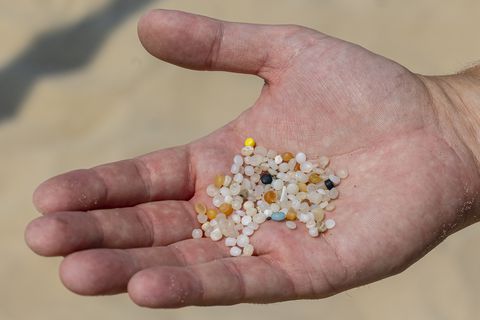
A 15-minute survey of plastics on North Beach in South Haven produces a handful of “nurdles,” industrial plastic pellets used for making products. (Joel Bissell | MLive.com)
The Plastic Pellet Free Waters Act is among Congressional or state bills aimed at curbing plastic pollution and moving toward a “circular economy” where all or most plastic waste is converted into raw material and new “virgin” plastic creation is reduced or eliminated.
To that end, the Break Free From Plastic Pollution Act would tax plastic bags and other containers, as set up a national bottle bill similar to Michigan’s 10-cent deposit program, and require manufacturers to manage single-use plastic container recycling.
States are already trying to shift the waste disposal cost burden to manufacturers through “extended producer responsibility” (EPR) laws. Maine and Oregon each passed bills this summer to force producers to manage and recycle more plastic waste. Similar bills are proposed in California, Hawaii, Maryland, Massachusetts and New York.
Such efforts are, perhaps unsurprisingly, opposed by industry.
The Break Free Act “would be absolutely devastating to manufacturing jobs and America’s overall economy just as we begin to rebound from the effects of COVID-19,” Tony Radoszewski, Plastic Industry Association president, said in March. “This bill is a direct threat to the nearly one million men and women who work in the domestic plastics industry.”
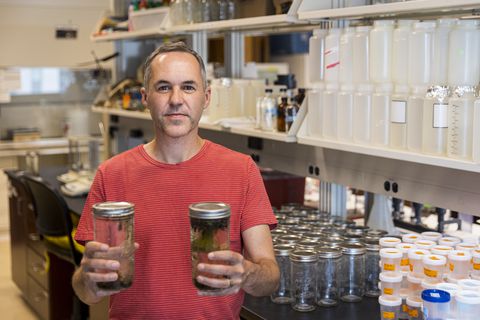
Aquatic Ecologist Tim Hoellein presents water samples from the Chicago River that were studied at his environmental research lab at Loyola University Chicago in Chicago, Ill. (Joel Bissell | MLive.com)
Tributaries delivering plastic that fish are eating
Ryan Baker stood on his friend Herb Theodore’s fishing boat and shook his head at the patch of trash clumped together in the Kalamazoo River log jam a few feet away.
Baker, president of the Kalamazoo River Alliance, a local anglers group, had organized a June 5 cleanup a couple months prior in which volunteers pulled more than 3,000 pounds of junk out of the river near downtown Kalamazoo. Then, July rains came and washed more trash from several urban creeks and an upstream homeless encampment into the river.
“In this section of river, once you get through downtown, every other logjam is the same story said Baker. “It’s milk bottles, pop bottles, one-gallon propane tanks. It’s a smorgasbord of junk.”
Tributaries like the Kalamazoo River transport significant quantities of plastics to the Great Lakes — although the actual amount that makes it to the lakes versus what sinks into river sediments is still being studied. What is clear is that rivers are bringing plastics from various sources to the lakes and, along the way, fish in those rivers are eating them.
In 2016 and 2017, Loyola University Chicago biologists sampled 74 fish from the Muskegon and St. Joseph rivers in Michigan and the Milwaukee River in Wisconsin and found that 85 percent had microplastics in their digestive tract, with an average of 13 particles per fish.
Birds are eating plastic, too. In 2019, University of Toronto researchers found microplastic in the digestive systems of double-crested cormorant chicks from Lake Ontario, who are suspected to have ingested the particles by eating fish that had consumed plastic.
Tim Hoellein, a Loyola ecologist who studies how plastic interacts with aquatic life, said microplastics are reaching waterways directly through wastewater plant discharges — and indirectly through wastewater biosolid sludges containing plastic that are spread on cropland as fertilizer. When it rains, those particles can move from soils into streams.
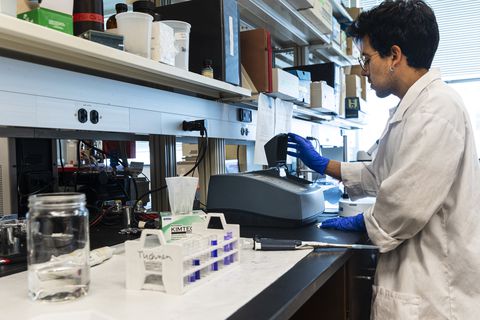
A Loyola University Chicago researcher processes water samples from the Great Lakes with colored dye at an environmental research lab at Loyola in Chicago, Ill. (Joel Bissell | MLive.com)
Research has also shown that microplastic fibers can spread through the air, depositing in remote or rural areas that lack concentrated sources. Sooner later, humans are ingesting them. A 2018 study found microplastic fibers in tap water drawn from the Great Lakes, beer brewed with Great Lakes source water, and commercial sea salt brands.
“The problem is waste,” said Hoellein. “It’s trash. It’s our waste management systems and our wastewater systems and, ultimately, probably, our consumer culture.”
Microplastic enters wastewater when synthetic fabrics like fleece jackets shed fibers in the washing machine — or, when landfill leachate is treated at water reclamation plants. Landfills are harsh conditions for plastic and accelerate breakdown, say researchers.
“We suspect a lot of microplastics being emitted from wastewater treatment plants are actually coming from the landfill leachate,” said John Scott, a chemist at the Illinois Sustainability Technology Center (ISTC) who studies microplastics.
In that respect, Scott sees parallels with another significant global emerging contaminant problem: the toxic ‘forever chemicals’ known as PFAS, which persist in the environment and are endemic in wastewater discharges as well as other Great Lakes ecosystems.
Unlike PFAS, microplastics aren’t generating the same level of concern from regulators or policymakers, in large part because their impact on humans is less clear.
“I honestly thought microplastics was going to be the emerging pollutant we in the wastewater busines were going to worry about, and then PFAS came along,” said Scott Schoolcraft, director of the North Kent Sewer Authority wastewater plant near Grand Rapids. “I suspect at some point it will become an issue. We’re all trying to fry other fish right now.”
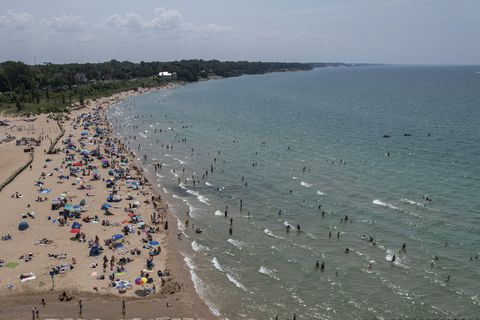
Swimmers and beachgoers fill South Beach in South Haven, MI. on July 28 2021. (Joel Bissell | MLive.com)
State regulators in Michigan are of similar mind.
“PFAS is much scarier to the average citizen than microplastics,” said Rich Hobrla, head of the Great Lakes Management Unit in the water resources division at the Michigan Department of Environment, Great Lakes and Energy (EGLE). “In general, people tend to respond more fiercely if they think something very directly affects their health. If there was some tie that suggested people who consume fish that ingest microplastics are more or highly susceptible to cancer, that’s the kind of thing that would really elevate the problem.”
Hobrla said EGLE relies on federal agencies for guidance on microplastics and sees its role as limited mostly to encouraging further research.
“It’s an important problem, but EGLE has to prioritize,” said Hobrla. “We have lots of important problems and they can’t all be at the top of the list. Unfortunately, this is one that’s not.”
61
